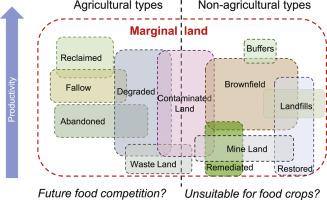Renewable and Sustainable Energy Reviews ( IF 16.3 ) Pub Date : 2020-08-17 , DOI: 10.1016/j.rser.2020.110220 P. Mellor , R.A. Lord , E. João , R. Thomas , A. Hursthouse

|
Concerns regarding global food security, direct or indirect land use change from bioenergy production require a better understanding of the alternative landbanks that may exist. The potential of ‘marginal’ land, whether for food or fuel production, has been the subject of much previous research but is currently compromised by the lack of a clear, globally accepted definition. A critical omission in the plethora of existing explicit or implicit definitions in use is the lack of comprehensive or consistent inclusion of non-agricultural land types, here re-defined as those now rendered unsuitable, unacceptable or permanently unavailable for food purposes. The result is variable inclusion of such land types in different areal studies, uncertainty regarding the nature of any land identified as ‘marginal’, in turn leading to inconsistent estimates of the role they could play in the provision of sustainable bioenergy.
The purpose of this research is to review the full range of possible ‘marginal’ land resources, especially those which are non-agricultural so avoid food competition, from previously-developed brownfield land, to former landfills or old mineral workings. Literature examples are compared to determine which land types have actually been included and quantified. In these case studies, non-agricultural types may equal other marginal lands at country or provincial scale, becoming dominant in urban regions. An inclusive definition is proposed, together with a graphic classification scheme, to guide future studies and enable quantification of truly non-agricultural marginal land as a potential contribution to sustainable bioenergy provision as part of the net zero, circular economy.
中文翻译:

确定非农业边缘土地作为实现可持续生物能源供应的途径-回顾与整体定义
有关全球粮食安全,生物能源生产带来的直接或间接土地利用变化的担忧需要对可能存在的替代土地库有更好的了解。无论是粮食还是燃料生产,“边际”土地的潜力一直是先前研究的主题,但由于缺乏明确的,全球公认的定义,目前受到了损害。大量使用的现有显式或隐式定义中的一个关键遗漏是缺乏对非农业土地类型的全面或一致的包含,此处将非农业土地类型重新定义为现已变得不合适,无法接受或永久无法用于粮食目的的土地类型。结果是在不同的区域研究中对这些土地类型进行了可变的包含,对于被确定为“边际”的任何土地的性质存在不确定性,
这项研究的目的是回顾所有可能的“边缘”土地资源,尤其是那些非农业的土地资源,从而避免粮食竞争,从以前开发的棕地土地到以前的垃圾填埋场或旧的矿藏。比较文献实例以确定哪些土地类型已被实际包括和量化。在这些案例研究中,非农业类型可能在国家或省级规模上等于其他边缘土地,在城市地区占主导地位。提出了一个包容性定义以及一个图形分类方案,以指导未来的研究,并能够对真正的非农业边缘土地进行量化,作为对可持续的生物能源提供的潜在贡献,作为净零循环经济的一部分。











































 京公网安备 11010802027423号
京公网安备 11010802027423号